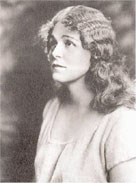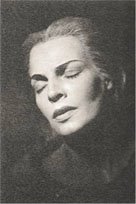Schizo
 Donizetti LUCIA DI LAMMERMOOR, Met prima, 24.IX.2007; c. Levine; Dessay, Giordani, Kwiecien, Relyea.
Donizetti LUCIA DI LAMMERMOOR, Met prima, 24.IX.2007; c. Levine; Dessay, Giordani, Kwiecien, Relyea.
Is it ok to say that everyone pretty much sucked in Acts I and II, but then redeemed themselves and their stellar careers in Act III? Starting from the top, Maestro James Levine, god of Mozart, Wagner, Strauss, and some Verdi, should be served a restraining order to keep him from screwing the bel canto repertory. His heavyhanded approach is toxic to the natural arch of these cornerstone Italian works: he has no oom-pa-pah, no relaxed, rhythmic gait that self-propels bel canto, instead choosing to color every phrase with a high romantic palette and thick textures. The result is a rudderless, claustrophobic submarine in pitch black waters, totally not what bel canto should feel, no matter how many lovers suffer and die on stage. Only when the Mad Scene happens, when Donizetti reels in the orchestration, does Levine become (once again) transcendent and masterful. This scene, and the Edgardo's Tomb Scene, are painted with mostly quiet and introspective phrases, which benefit from the slow-and-slower, piano-and-pianoer technique that our Maestro has patented.
The singers are similarly schizophrenic. Natalie Dessay has this mannerism that I don't get: a kind of pop-inspired portamento, sliding from note to note like she's the country songbird Anne Murray crooning a prairie ditty. I like a dash of staccato here and there, a more direct attack on some notes (especially above the staff). If I want to hear Celine Dion-type singing, I'd ... uhm, I guess I'd rather kill myself before that happens. (I wonder if French pop music in her teen years has something to do with this idiosyncrasy.) She is an unparalleled Zerbinetta, but Zerbinetta sensibility leaves arias like "Regnava nel silenzio" cold and displaced. These things, however, are quickly forgiven because everything about her voice works miraculously well in the Mad Scene. Here, she is simply magnificent: sophisticated shading, total emotional investment in every phrase, technically competitive coloratura (though high-note-shy and somewhat trill-challenged), and skillful use of pianos and diminuendos. Her spellbinding scene more than washes away the ickiness of prior scenes. Dessay reestablishes her grip on the Lucia trophy, and Sieglinde's not raising any objection. (Though she might want to reconsider that wretched Klytamnestra scream that she unleashed just prior to the cabaletta. Whoever agreed with you that it was a good idea should be screamed off the staff and into the unemployment line.)
It is now established custom that Marcello Giordani starts his evenings with stuffed nasal passages and a serious hangover: lazy, nasal, rough, scratchy singing dominates his every Act I since the beginning of time. But we've learned the virtues of patience and perseverance, and right at the point when you're truly tested as a fan, he delivers when it absolutely counts. His Tomb Scene is the rare combination of virile masculinity and extreme sensitivity: thoroughly touching, sorrowful, but never weak. The auditorium shook in his impeccable squillo, and we choked up with the natural sob of his timbre.
Mary Zzzimmerman, the spawn of Zzzeffirelli and Zzzambello, overflows with ideas, some of them interesting, a number quite distracting, and a couple totally genius. If the photographer in the sextet pares his actions down considerably, the conceit would have been more effective. I actually liked the idea of successively pulling everyone into the photo viewfinder the way Donizetti did musically in his expanding sextet and chorus. Elsewhere, her Zeffirelliesque Act II curtains failed her--velcro is always bad news--and her Zambelloesque white lady ghosts in Act I and III were a total flop. Dessay's Tomb Scene apparition was a scene stealer-- more accurately, a "scene distracter" (if Merriam or Webster will let me), much like a number of other details that Zimmerman cooked up. For his final scene, Giordani was building a truly moving posture (and you can feel the tears about to fall)-- till the Dessay ghost enters the view quite unexpectedly, and with hideous hair and makeup, thus shattering the beautiful arch. Dessay was probably more than happy to oblige Zimmerman on this one, because she herself had many scenes stolen from her elsewhere in the evening. (The downside: curtain calls looking really, really scary.) But putting aside this misfire, her Mad and Tomb Scenes were on the mark. Dessay reveled in the athletic demands of Zimmerman's staircase, gliding over the large set (ostensibly borrowed from the Traviata production) with the same ease she possessed vocally. And what a grand, grand exit: Lucia's lifeless body being carried by three men solemnly up the stairs after all the music has ended, pausing for a few seconds after every step-- I have not witnessed a more brava-inducing maneuver.
Rounding up the rest of the cast: Mariusz Kwiecien sang with too much fervor and not enough elegance; John Relyea was just about perfect; Stephen Costello, debuting as Arturo, milked his one stanza for all its worth: he is on his way to lovely lyric career.
But stopping here, because Sieglinde has to do her morning run. (She's fat from consecutive Chinese food meals. She likes her salt-baked porkchops, need I explain.) Certainly many, many more things to say, so watch for updates in the coming days. Will post more pics later as well.



